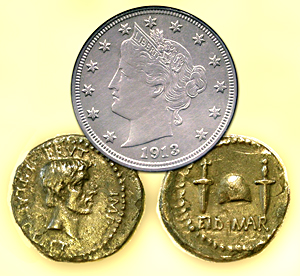|
"Making Cents"
The Signal
Saturday, March 17, 2007
| M |
For example, among Lincoln cents, the 1917 doubled-die cent is scarce to rare, depending on condition. Only a very few are known in mint condition, and even the nicest known pieces will sell for $2,500 to $5,000.
On the other hand, the 1955 doubled-die Lincoln cent — of which several thousand are known — can bring $25,000 or more at auction in Mint State-65 Red condition, even though there are at least 15 pieces in that grade and hundreds more in lesser uncirculated grades.
Among Morgan dollars, the two most common dates are the first year of issue, 1878, and the last year of issue, 1921. The most valuable date and mintmark combinations in the series include the 1879-CC, 1889-CC, 1895 and 1901 in MS-65 or higher condition. Age is not a factor.
The oldest of the "V" (Liberty Head) nickels is the 1883. In mint condition, it is still among the least expensive coins in the series, which ran until 1912. The scarcest coins are the 1885 and the 1912-S.
In a few series of coins, the first year of issue (i.e., the oldest in the series) is also among the most valuable in the series. This includes the 1909-S VDB Lincoln cent, the 1916 Standing Liberty quarter, the 1916-D Mercury dime, the 1932-D and 1932-S Washington quarter and the 1921 Peace dollar.
United States coins dated before 1800 are all scarce to rare, and the actual age is not a factor in value; condition is more often the prime valuator. With these early issues, there are many varieties that often raise the value to great heights — such as the "starred" reverse large cent, or the Jefferson variety large cent. Age is not a factor; more important are the actual mintage figures and the known population (surviving numbers) of each coin.
Many pre-1800 coins had mintages of only a few thousand, and the known surviving specimens number in the dozens, or even less.
One of my favorite questions from a reader went like this: "I have a nice, shiny Buffalo nickel. What is it worth?" "What is the date?" I asked. "I canšt tell — it is worn off, but it is real old and real shiny."
Dateless Buffalo nickels are worth about 10 cents. Age is definitely not a factor.
Collectors (or their heirs) often wonder why the proof sets they (or their parents) put away in the 1960s and early '70s are not worth a lot more than the proof sets of the 1980s or 2000s.
In the summer of 1964, proof sets with the new Kennedy half dollar were selling for up to $30. By December 1964, they were selling in the $5 range. Today they sell for about $15. On the other hand, proof sets issued in 1986, 1997 and 2001 sell for considerably more than the issue price. Age is not a factor.
Another question from a reader: "I received 10 silver dollars from my grandmother when I was a little girl around 1920, and I was told to hang onto them and they would be worth thousands of dollars some day."
When I asked the dates of the coins, she said, "They are all 1878, the oldest Morgan dollars."
When I said I could sell her more of these same silver dollars in mint condition for about $15 each — this was a few years ago — she said I was just trying to steal her coins and hung up on me. I am certain her heirs eventually sold the coins for market value when she was gone — and certainly not for "thousands of dollars." Age is not a factor.
The notion of age equaling value is hard to unlearn. In Italy, Greece and other Mediterranean countries, you can buy genuine ancient bronze coins for a couple of dollars each. They are very old. If they appreciated even 1 percent per year, they should be worth hundreds of dollars. Yet, a few hundred years from now, they still should be worth only a few dollars each — since age is not a factor.
By coincidence, the highest valued coins — those over $1 million — were mostly 20th-century coins, including the 1933 $20 gold piece, all five 1913 Liberty Head nickels, an ultra-high relief 1907 $20 gold piece and a 1927-D $20 gold piece.
In each case, rarity and desirability were the two factors that propelled these coins into the seven-figure range — not age.
Dr. Sol Taylor of Sherman Oaks is president of the Society of Lincoln Cent Collectors and author of The Standard Guide to the Lincoln Cent. Click here for ordering information.
©2007, THE SIGNAL · ALL RIGHTS RESERVED.

![[Most Recent Quotes from www.kitco.com]](http://www.kitconet.com/images/quotes_special.gif)

